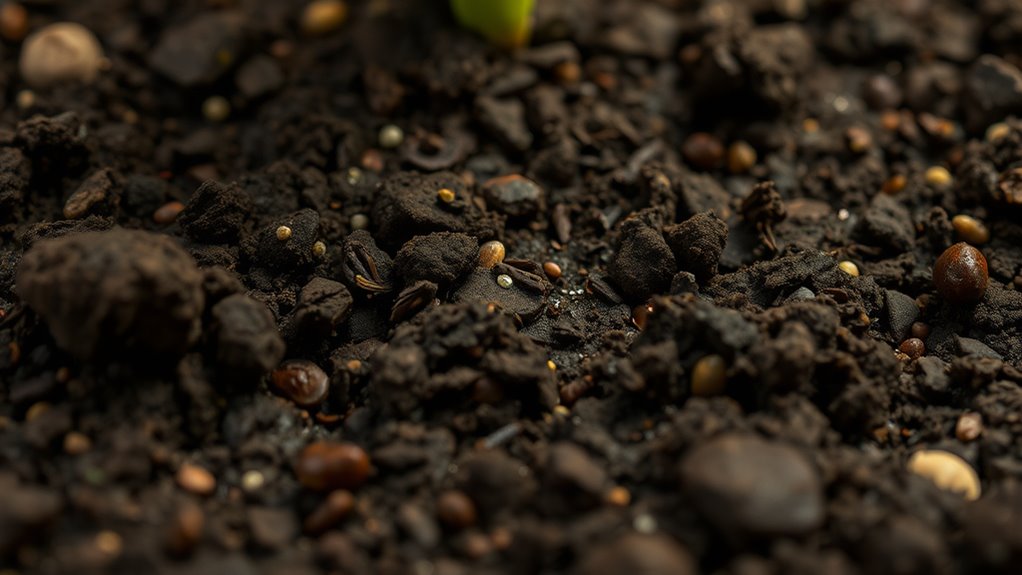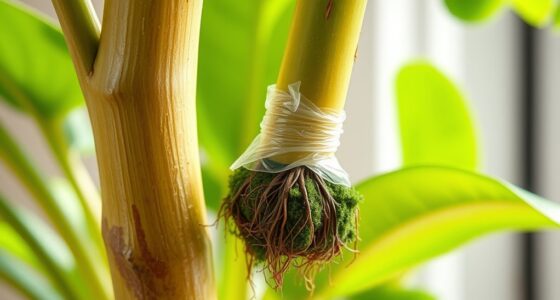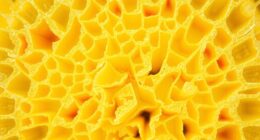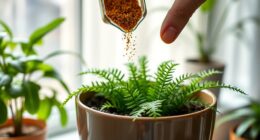Yes, beneficial microbes can survive in indoor pots when you provide the right conditions. Using organic soil, compost, and organic amendments introduces a variety of helpful bacteria and fungi. Maintaining proper moisture and avoiding harsh chemicals creates an environment where these microbes can thrive. Regular organic feeding supports their activity, helping your plants stay healthy. If you want to learn how to foster a resilient soil biome inside your containers, keep exploring the best practices for indoor microbes.
Key Takeaways
- Beneficial microbes can survive indoors if soil conditions are kept moist, not waterlogged, and free of harsh chemicals.
- Organic soil with compost and amendments supports thriving microbial communities inside pots.
- Proper watering, avoiding overwatering and drying out, helps maintain a healthy microbial balance.
- Moderate temperatures and consistent indoor environments favor microbial survival and activity.
- Regular organic feeding and minimal chemical use promote resilient beneficial microbes in potted soil.
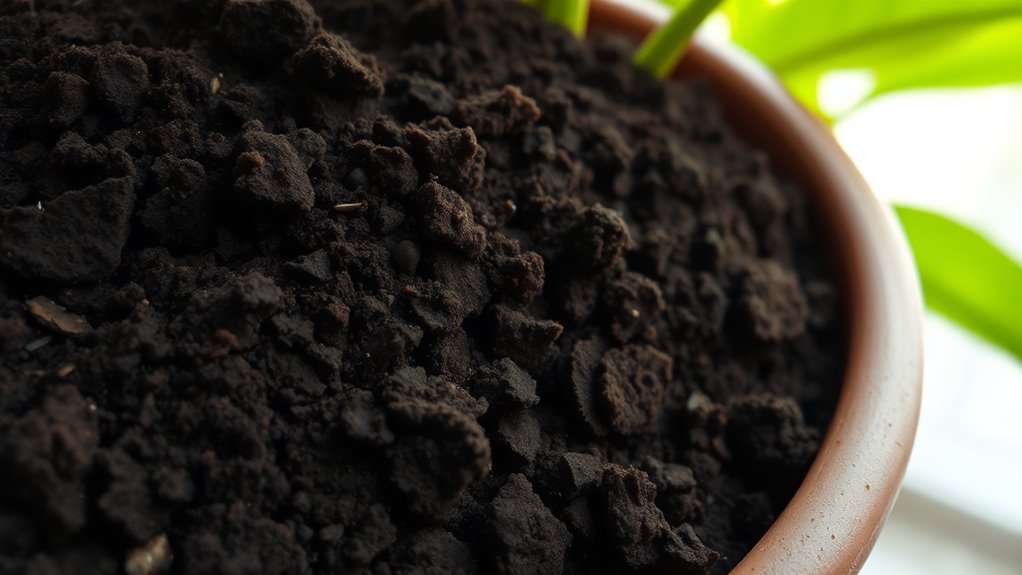
Have you ever considered that you can bring the rich diversity of a soil biome right into your home? Many people think of soil microbes as something that only exists outdoors, thriving in vast fields and gardens. But the truth is, beneficial microbes can survive and even flourish inside pots, provided you create the right environment. These tiny organisms form complex communities that support plant health, improve nutrient uptake, and protect against pests and diseases. Understanding whether they can survive indoors hinges on a few key factors, like soil quality, moisture, and plant care practices.
First, it’s important to realize that beneficial microbes are quite resilient. They’ve evolved to exist in diverse environments, including the challenging conditions of potting soil. When you fill a pot with healthy, organic soil, you’re essentially creating a miniature ecosystem. If the soil contains compost, worm castings, or other organic amendments, you’re introducing a wide array of microbes—bacteria, fungi, and other microorganisms—that can establish themselves quickly. These microbes are not just surviving; they’re actively working to break down organic matter, release nutrients, and foster a thriving root microbiome.
However, sustaining these beneficial microbes over time depends on your care routine. Overwatering can drown the microbes, washing them away or creating anaerobic conditions that favor harmful organisms. Conversely, letting the soil dry out completely can kill off some of the more sensitive beneficial microorganisms. Striking a balance—maintaining consistent moisture without waterlogging—is key. Also, avoid harsh chemical fertilizers or pesticides that can wipe out microbial communities. Instead, opt for organic fertilizers or compost teas that nourish both your plants and their microbial allies.
Temperature and light also play a role. Most beneficial microbes prefer moderate temperatures and a bit of organic material to feed on. As long as your indoor environment stays within a comfortable range for your plants, the microbes will thrive. Regularly adding organic matter, like compost or natural amendments, keeps the microbial population active and diverse. This ongoing input helps sustain a lively, resilient soil biome inside your pots.
In reality, the microbes in your indoor soil aren’t just surviving—they’re actively contributing to a healthier, more self-sustaining plant environment. With proper care—good watering practices, organic feeding, and maintaining suitable conditions—you create a cozy habitat for these beneficial organisms. So yes, beneficial microbes can survive indoors and, with a little attention, you can keep your soil biome vibrant and working for your plants’ health every day.
Frequently Asked Questions
Can Beneficial Microbes Be Harmful Indoors?
Beneficial microbes generally aren’t harmful indoors. They help improve soil health, boost plant growth, and fight off harmful pathogens. However, if you introduce them improperly or in excessive amounts, they could potentially cause issues like mold or unwanted microbial growth. To keep things safe, follow product instructions carefully, maintain good hygiene, and monitor your plants regularly. When used properly, beneficial microbes enhance your indoor gardening without posing risks.
How Do I Introduce Microbes Into My Indoor Soil?
Imagine you’re in a lush rainforest, ready to bring that vigor home. To introduce microbes into your indoor soil, start by adding a microbial inoculant or compost tea, which contains beneficial bacteria and fungi. Mix it thoroughly into the soil, and keep your plants healthy and hydrated. You can also introduce compost or organic matter regularly, providing food for microbes to thrive and create a thriving, balanced soil ecosystem indoors.
Do Microbes Affect Indoor Plant Pests?
Yes, microbes can affect indoor plant pests. Beneficial microbes, like certain bacteria and fungi, can suppress pests by outcompeting harmful organisms or producing natural pest repellents. When you introduce these microbes into your soil, they create a healthy environment that discourages pests from settling in. This biological control method reduces the need for chemical pesticides, helping your plants stay healthy and pest-free naturally.
How Long Do Beneficial Microbes Survive Indoors?
Beneficial microbes can survive indoors for several months, with some living up to a year if conditions stay favorable. Did you know that a healthy microbial community can improve plant growth by up to 30%? You should regularly maintain proper moisture, avoid over-fertilizing, and keep the environment clean. These steps help microbes thrive, ensuring your indoor plants stay healthy and vibrant for as long as possible.
Is Special Soil Needed for Microbial Growth Indoors?
You don’t necessarily need special soil for beneficial microbes to grow indoors. Regular potting mixes often contain organic matter and nutrients that support microbial life. To boost their survival, you can add compost or microbial inoculants. Keep your soil moist, provide adequate airflow, and avoid over-fertilizing, which can harm microbes. With proper care, beneficial microbes will thrive and improve your plants’ health indoors.
Conclusion
So, next time you toss a handful of soil into your indoor pots, remember—you’re inviting a tiny army of beneficial microbes to party in your living room. With their microscopic antics, they’ll turn your space into a lush jungle, not just a sterile showroom. Who knew that beneath your plant’s leaves, a covert microbial metropolis could thrive, proving that even indoors, life finds a way—one soil particle at a time.

